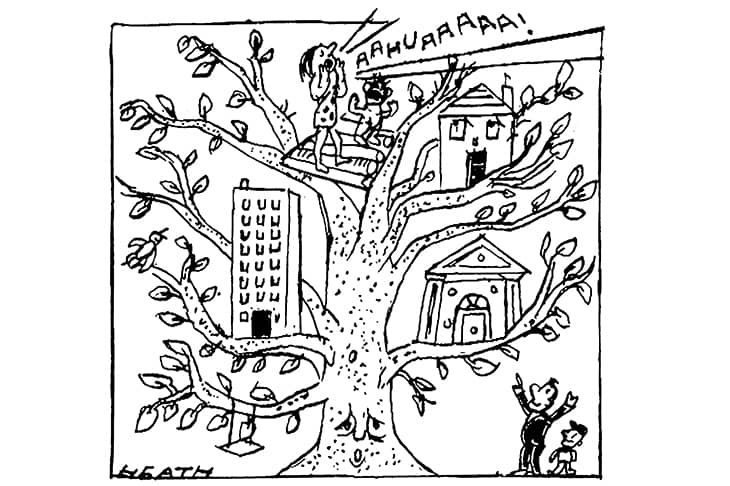You can’t (and probably shouldn’t) design a treehouse. Treehouses should grow organically, in every sense: they must be made of wood, obviously — one definition of a treehouse is that it is a tree holding its dead friend — and the footings for the platform must be the knots or branches that are footholds when climbing the tree. Besides, it is only when you are halfway through building that you can work out where you need to fit round branches and add noggins — unless you build it between the trunks of two separate trees, or use some sort of 3D mapping software, both of which sound very much like cheating.
So there wasn’t any masterplan behind my son’s treehouse. I bought some 2x4s in the first lockdown — timber merchants were the only shops open — and fitted them together in my head and the tree. My son had his own amendments (he thought that there should be a rope ladder he could raise and a trap door he could shut to escape from his enemies, which seemed like a very sensible precaution) and I had mine.
I had vaguely thought about making the walls from shiplap or featheredge but my wife pointed out it would look like a shed rather than a treehouse, and the boy was at least 30 years too young to be excited by a shed. Instead I found semi-circular rails, like the ones used to fence horse paddocks, on sale in an agricultural cooperative and screwed them next to each other with carriage bolts. And because the treehouse had never been designed — had never even been sketched out on paper — it was only when it was complete that I realised where I had seen that design before. It was the birthday cake that my mother always made for me as a child — a chocolate fort with chocolate fingers lining the outside.
I think what I am saying is that treehouses have a special place in our unconscious. I was always envious of children who had one when I was growing up — my parents’ largest tree was a silver birch, which could only just cope with a birdhouse — but I could never say why. Nor why, on my first look round the house my wife and I eventually bought, the first thing I noticed was the mature tree in the garden with its capability for improvements; nor why, when it was finally erected, every child who visits excitedly runs to investigate.
Literary critics, trying to explain why so many children’s books are set in treehouses, talk about liminality: living in a tree you are on the boundary of things, in the air but connected to the earth, close to the wildness of the woods but near enough to the house to call for help if the trapdoor lands on your fingers. It is a safe form of wildness.
But I suspect it goes deeper than that: perhaps even as deep as a primeval memory of our arboreal ancestors. Psychologists talk about prospect-and-refuge theory, the idea that we have evolved to desire places that give us a protected view over our world, whether it’s the Serengeti or your father’s lawn. My son’s treehouse is the perfect example: every prospect pleases, but is a well-hidden refuge, being painted green to camouflage it from his enemies. I have never asked him who these potential enemies are. Mostly because I suspect it is his mother and me. Which is just as it should be.






Comments